Consider the incompressible and irrotational flow around a R
Consider the incompressible and irrotational flow around a Rankine half-body...
Consider the incompressible and irrotational flow around a Rankine half-body (cf. Figure 1). The flow can be modeled using the superposition of a source at point (a. b) and a uniform flow in the redirection. Suppose that we would like to model the flow around a halfbody that is inclined (relative to the horizontal) at an angle alpha (i.e. it is rotated CCW by an angle alpha). Find the velocity potential function Psi for the inclined half-body in terms of x and y coordinates. Find the stream function Phi for the inclined half-body in terms of x and y coordinates. Utilizing your answer to part (a), find expressions for the velocity components u and v. Utilizing your answer to part (b). find expressions for the velocity components u and v. Show that the Laplacian of Psi is equal to zero. Show that the Laplacian of Phi is equal to zero. Find an expression for the pressure coefficient that is valid for all points in the flow. Neglect gravitational forces, and assume that Bernoulli\'s equation applies.Solution
ø = øUniform flow(UF) + øSource(S)
= - (q/2) ln(r )- Ux
‘q= volume flow rate per unit width
r- Radius
b) Stream function,
j = jUF + jS
= (q/2) - Vy
c) Velocity component from (a)
Ur= Ucos + m/(2r)
d) Velocity component from (b)
V = Usin
e) The equation for z component of vorticity is
v/ x - u/ y =
For irrotational flows , the condition irrotantionality is = 0
v/ x - u/ y = 0
Now in irrotantionality, the scalar function of ø is as follows
‘u = ø/x v= ø/y ………………(1)
Substituting this in vorticity equation, we get
2 ø/xy - 2 ø/yx
=2 ø/xy -2 ø/xy
= 0
Which illustrates that we can write velocity vector u = (u,v) as gradient scalar function of ø. i.e.
If u = ø, x u = 0
Substituting 1 in continuity equation (u/x + v/y= 0)
2 ø/x2 + 2 ø/y2 = 0
As from above we can see laplacian of ø is zero.
f) The equation for z component of vorticity is
v/ x - u/ y =
For irrotational flows , the condition irrotantionality is = 0
v/ x - u/ y = 0
Now in irrotantionality, the scalar function of ø is as follows
‘u = /x v= /y ………………(1)
Substituting this in vorticity equation, we get
2 /xy - 2 /yx
=2 /xy - 2 /xy
= 0
Which illustrates that we can write velocity vector u = (u,v) as gradient scalar function of ø. i.e.
If u = ø, x u = 0
Substituting 1 in continuity equation (u/x + v/y= 0)
2 /x2 + 2 /y2 = 0
As from above we can see laplacian of is zero.
g) Continuity equation, u/x + v/y= 0
Assuming liquid to be perfect with steady flow& neglecting gravity eulers equation can be described as
u u/x + v v/y = - (1/p) p/x
u v/x + v v/y = - (1/p) p/y
Simplifying this equations
(u2/2)/x + v u/y = (p/p)/x
Adding & subtracting
/x ( u2/2 + v2/2 ) -/x ( (v2/2) + v u/y = - P/x
Rearranging,
/y (u2/2 + v2/2 + P/) = - u (v/x - u/y)
We know that equation for z component of vorticity is
v/x - u/y = 0 (for irrotational flows)
u2/2 + v2/2 + P/ = H (bernouli equation)
H is constant
If flow is uniform @ speeds U
u2/2 + v2/2 + P/ = U2/2 + P/
Rearranging the equation we get, pressure coefficient
Cp = (- P)/(0.5 U2) = 1 – {(u2 + v2)/ U2}
ø = øUniform flow(UF) + øSource(S)
= - (q/2) ln(r )- Ux
‘q= volume flow rate per unit width
r- Radius
b) Stream function,
j = jUF + jS
= (q/2) - Vy
c) Velocity component from (a)
Ur= Ucos + m/(2r)
d) Velocity component from (b)
V = Usin
e) The equation for z component of vorticity is
v/ x - u/ y =
For irrotational flows , the condition irrotantionality is = 0
v/ x - u/ y = 0
Now in irrotantionality, the scalar function of ø is as follows
‘u = ø/x v= ø/y ………………(1)
Substituting this in vorticity equation, we get
2 ø/xy - 2 ø/yx
=2 ø/xy -2 ø/xy
= 0
Which illustrates that we can write velocity vector u = (u,v) as gradient scalar function of ø. i.e.
If u = ø, x u = 0
Substituting 1 in continuity equation (u/x + v/y= 0)
2 ø/x2 + 2 ø/y2 = 0
As from above we can see laplacian of ø is zero.
f) The equation for z component of vorticity is
v/ x - u/ y =
For irrotational flows , the condition irrotantionality is = 0
v/ x - u/ y = 0
Now in irrotantionality, the scalar function of ø is as follows
‘u = /x v= /y ………………(1)
Substituting this in vorticity equation, we get
2 /xy - 2 /yx
=2 /xy - 2 /xy
= 0
Which illustrates that we can write velocity vector u = (u,v) as gradient scalar function of ø. i.e.
If u = ø, x u = 0
Substituting 1 in continuity equation (u/x + v/y= 0)
2 /x2 + 2 /y2 = 0
As from above we can see laplacian of is zero.
g) Continuity equation, u/x + v/y= 0
Assuming liquid to be perfect with steady flow& neglecting gravity eulers equation can be described as
u u/x + v v/y = - (1/p) p/x
u v/x + v v/y = - (1/p) p/y
Simplifying this equations
(u2/2)/x + v u/y = (p/p)/x
Adding & subtracting
/x ( u2/2 + v2/2 ) -/x ( (v2/2) + v u/y = - P/x
Rearranging,
/y (u2/2 + v2/2 + P/) = - u (v/x - u/y)
We know that equation for z component of vorticity is
v/x - u/y = 0 (for irrotational flows)
u2/2 + v2/2 + P/ = H (bernouli equation)
H is constant
If flow is uniform @ speeds U
u2/2 + v2/2 + P/ = U2/2 + P/
Rearranging the equation we get, pressure coefficient
Cp = (- P)/(0.5 U2) = 1 – {(u2 + v2)/ U2}
ø = øUniform flow(UF) + øSource(S)
= - (q/2) ln(r )- Ux
‘q= volume flow rate per unit width
r- Radius
b) Stream function,
j = jUF + jS
= (q/2) - Vy
c) Velocity component from (a)
Ur= Ucos + m/(2r)
d) Velocity component from (b)
V = Usin
e) The equation for z component of vorticity is
v/ x - u/ y =
For irrotational flows , the condition irrotantionality is = 0
v/ x - u/ y = 0
Now in irrotantionality, the scalar function of ø is as follows
‘u = ø/x v= ø/y ………………(1)
Substituting this in vorticity equation, we get
2 ø/xy - 2 ø/yx
=2 ø/xy -2 ø/xy
= 0
Which illustrates that we can write velocity vector u = (u,v) as gradient scalar function of ø. i.e.
If u = ø, x u = 0
Substituting 1 in continuity equation (u/x + v/y= 0)
2 ø/x2 + 2 ø/y2 = 0
As from above we can see laplacian of ø is zero.
f) The equation for z component of vorticity is
v/ x - u/ y =
For irrotational flows , the condition irrotantionality is = 0
v/ x - u/ y = 0
Now in irrotantionality, the scalar function of ø is as follows
‘u = /x v= /y ………………(1)
Substituting this in vorticity equation, we get
2 /xy - 2 /yx
=2 /xy - 2 /xy
= 0
Which illustrates that we can write velocity vector u = (u,v) as gradient scalar function of ø. i.e.
If u = ø, x u = 0
Substituting 1 in continuity equation (u/x + v/y= 0)
2 /x2 + 2 /y2 = 0
As from above we can see laplacian of is zero.
g) Continuity equation, u/x + v/y= 0
Assuming liquid to be perfect with steady flow& neglecting gravity eulers equation can be described as
u u/x + v v/y = - (1/p) p/x
u v/x + v v/y = - (1/p) p/y
Simplifying this equations
(u2/2)/x + v u/y = (p/p)/x
Adding & subtracting
/x ( u2/2 + v2/2 ) -/x ( (v2/2) + v u/y = - P/x
Rearranging,
/y (u2/2 + v2/2 + P/) = - u (v/x - u/y)
We know that equation for z component of vorticity is
v/x - u/y = 0 (for irrotational flows)
u2/2 + v2/2 + P/ = H (bernouli equation)
H is constant
If flow is uniform @ speeds U
u2/2 + v2/2 + P/ = U2/2 + P/
Rearranging the equation we get, pressure coefficient
Cp = (- P)/(0.5 U2) = 1 – {(u2 + v2)/ U2}
Velocity potential function ,
ø = øUniform flow(UF) + øSource(S)
= - (q/2) ln(r )- Ux
‘q= volume flow rate per unit width
r- Radius
b) Stream function,
j = jUF + jS
= (q/2) - Vy
c) Velocity component from (a)
Ur= Ucos + m/(2r)
d) Velocity component from (b)
V = Usin
e) The equation for z component of vorticity is
v/ x - u/ y =
For irrotational flows , the condition irrotantionality is = 0
v/ x - u/ y = 0
Now in irrotantionality, the scalar function of ø is as follows
‘u = ø/x v= ø/y ………………(1)
Substituting this in vorticity equation, we get
2 ø/xy - 2 ø/yx
=2 ø/xy -2 ø/xy
= 0
Which illustrates that we can write velocity vector u = (u,v) as gradient scalar function of ø. i.e.
If u = ø, x u = 0
Substituting 1 in continuity equation (u/x + v/y= 0)
2 ø/x2 + 2 ø/y2 = 0
As from above we can see laplacian of ø is zero.
f) The equation for z component of vorticity is
v/ x - u/ y =
For irrotational flows , the condition irrotantionality is = 0
v/ x - u/ y = 0
Now in irrotantionality, the scalar function of ø is as follows
‘u = /x v= /y ………………(1)
Substituting this in vorticity equation, we get
2 /xy - 2 /yx
=2 /xy - 2 /xy
= 0
Which illustrates that we can write velocity vector u = (u,v) as gradient scalar function of ø. i.e.
If u = ø, x u = 0
Substituting 1 in continuity equation (u/x + v/y= 0)
2 /x2 + 2 /y2 = 0
As from above we can see laplacian of is zero.
g) Continuity equation, u/x + v/y= 0
Assuming liquid to be perfect with steady flow& neglecting gravity eulers equation can be described as
u u/x + v v/y = - (1/p) p/x
u v/x + v v/y = - (1/p) p/y
Simplifying this equations
(u2/2)/x + v u/y = (p/p)/x
Adding & subtracting
/x ( u2/2 + v2/2 ) -/x ( (v2/2) + v u/y = - P/x
Rearranging,
/y (u2/2 + v2/2 + P/) = - u (v/x - u/y)
We know that equation for z component of vorticity is
v/x - u/y = 0 (for irrotational flows)
u2/2 + v2/2 + P/ = H (bernouli equation)
H is constant
If flow is uniform @ speeds U
u2/2 + v2/2 + P/ = U2/2 + P/
Rearranging the equation we get, pressure coefficient
Cp = (- P)/(0.5 U2) = 1 – {(u2 + v2)/ U2}
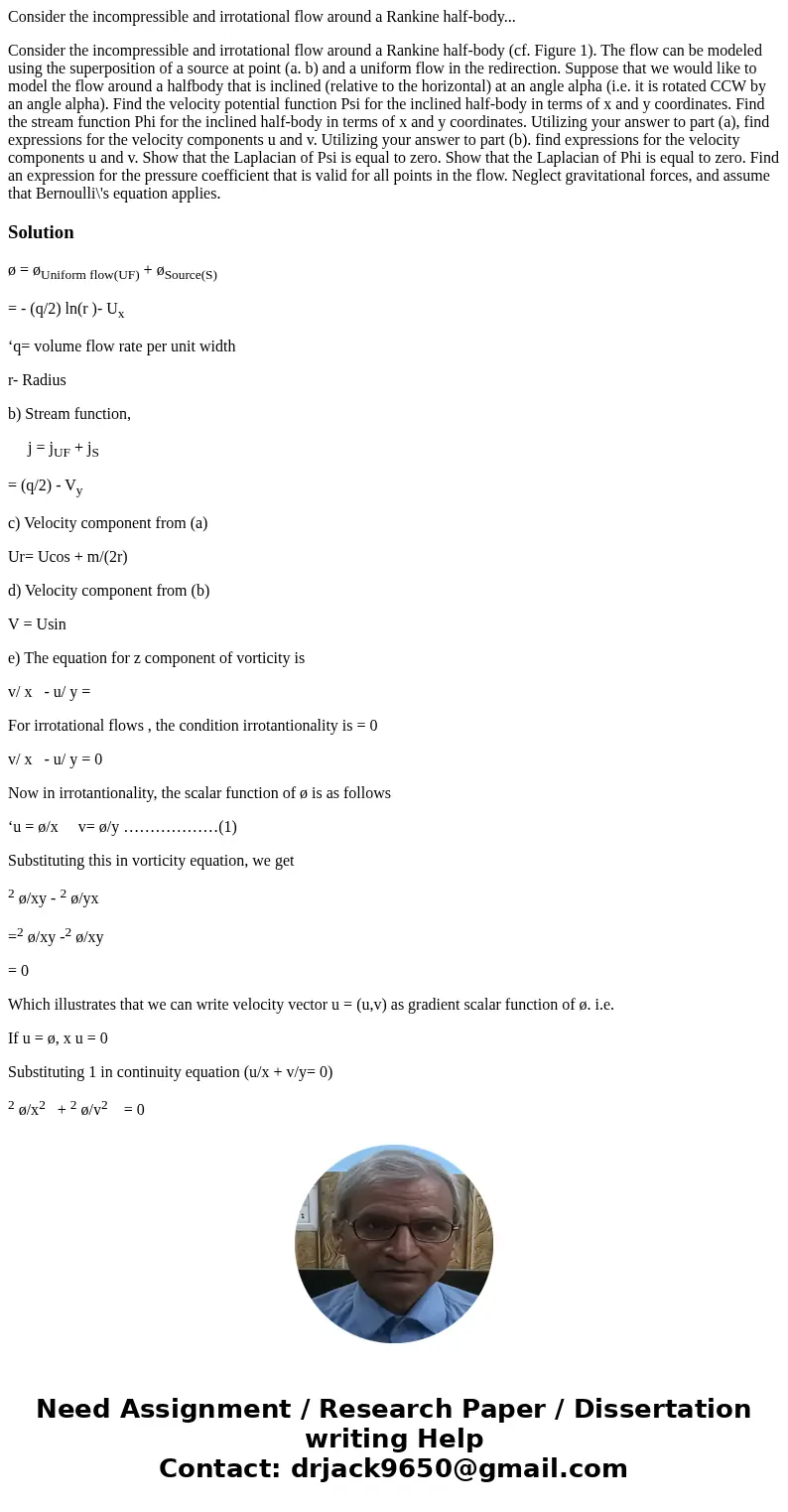
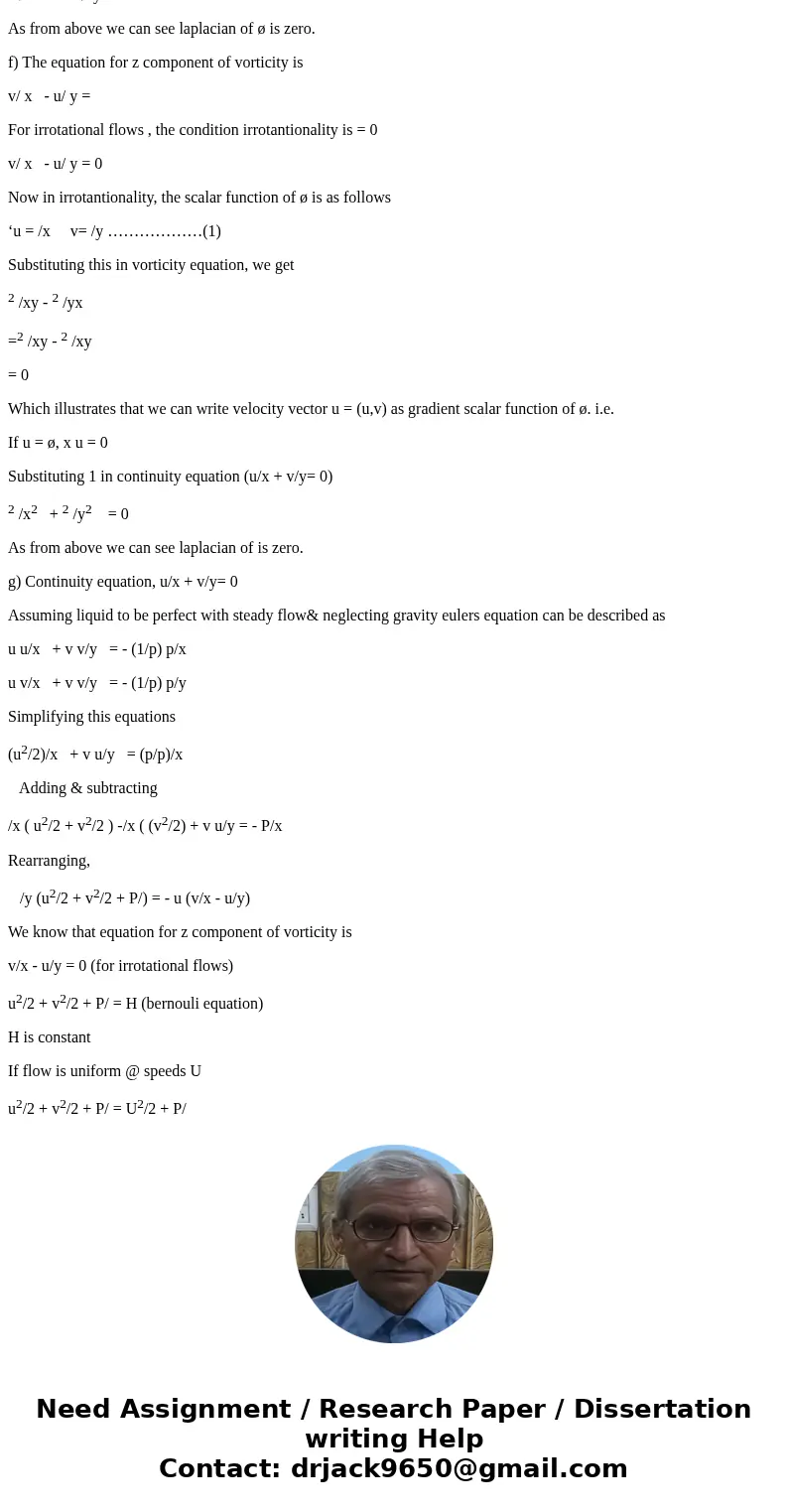
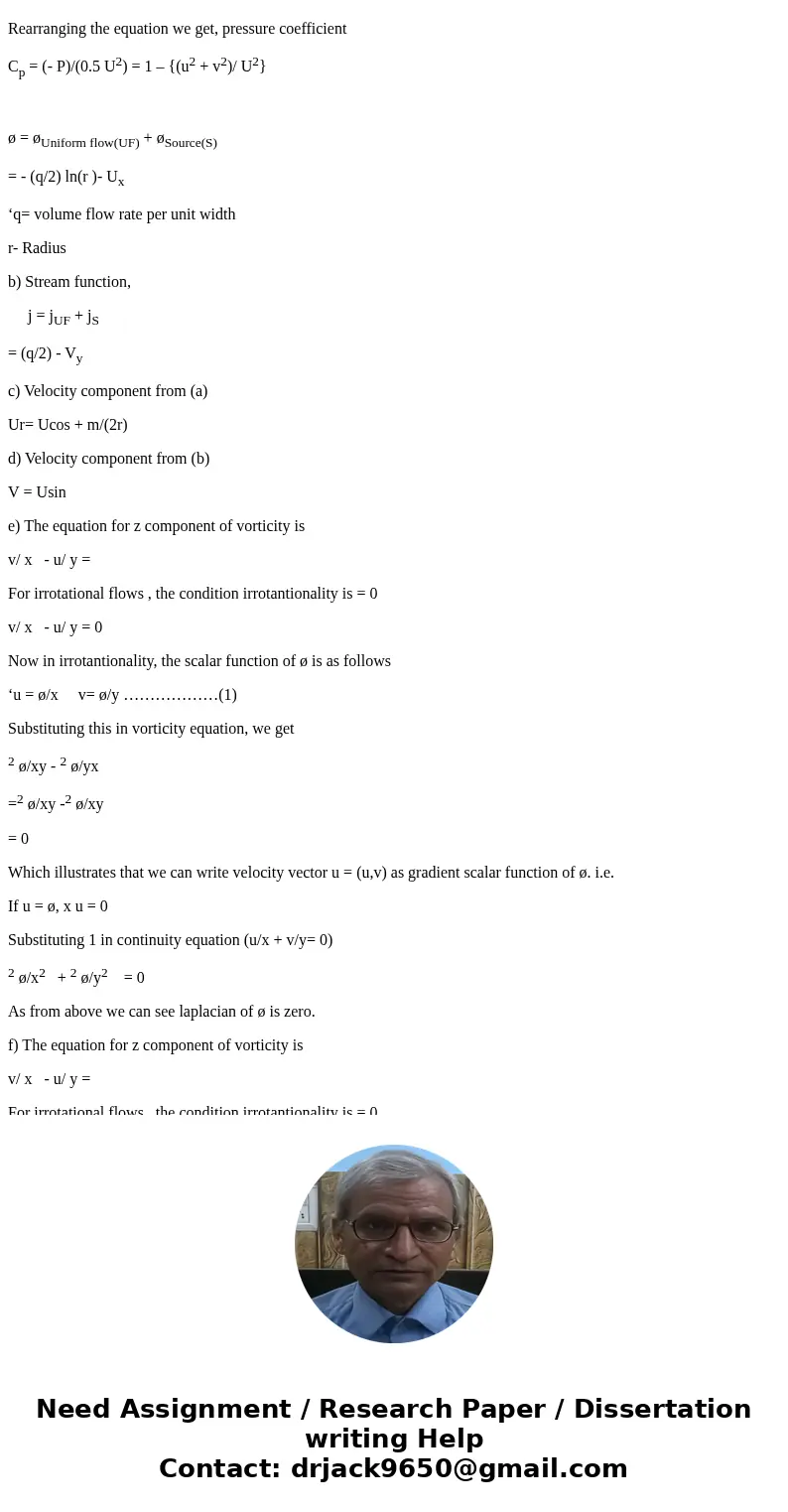
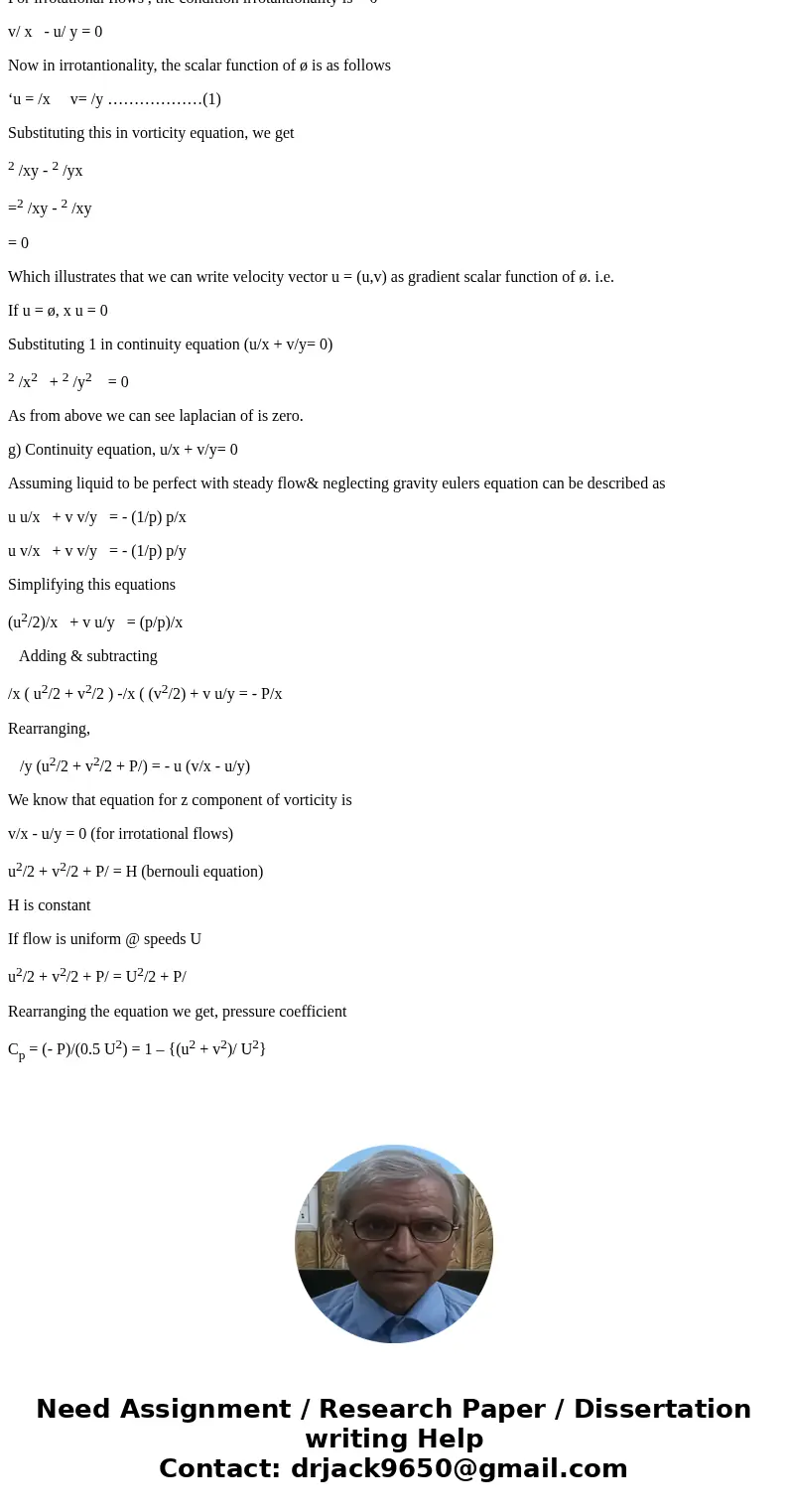
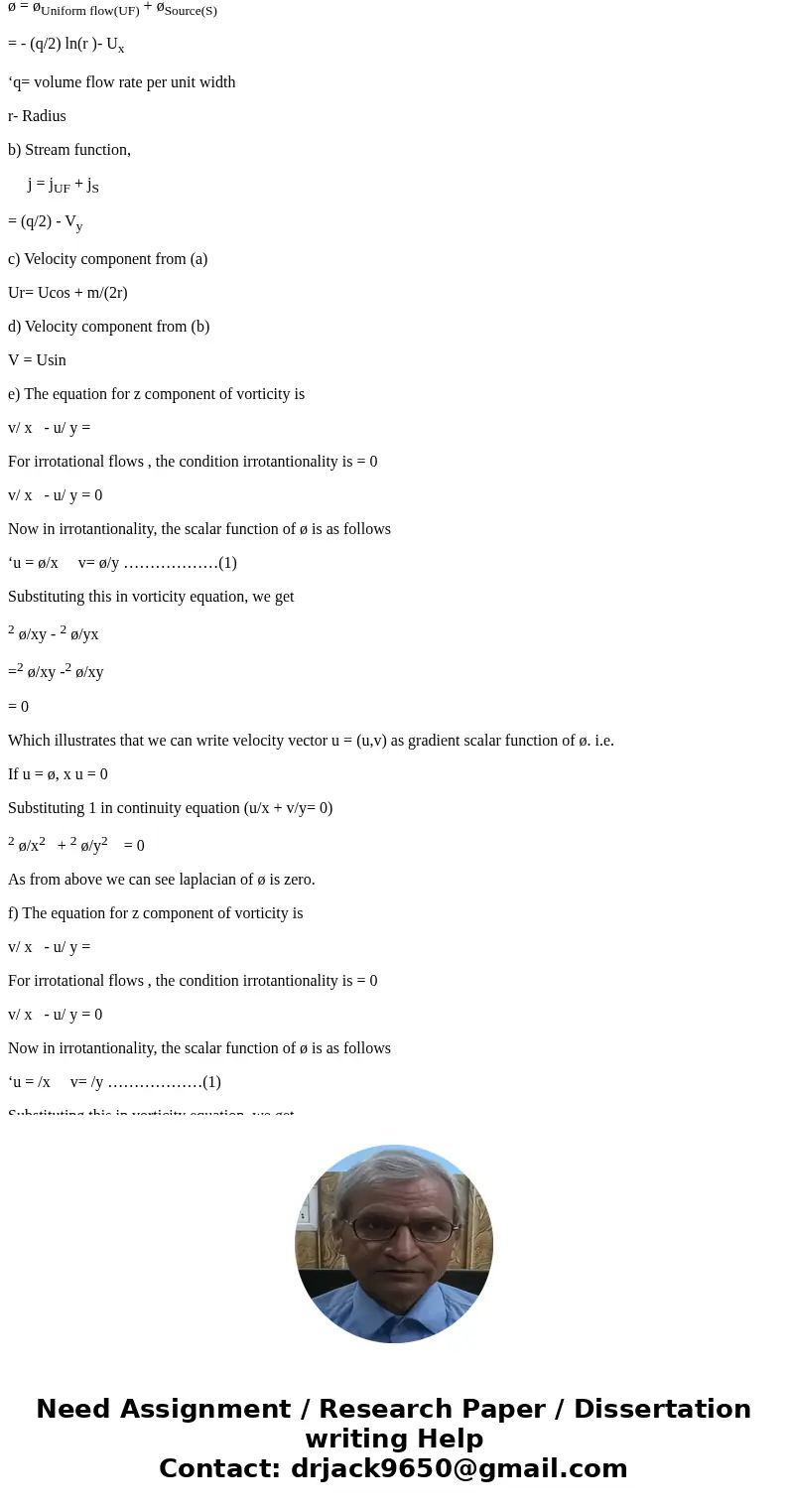
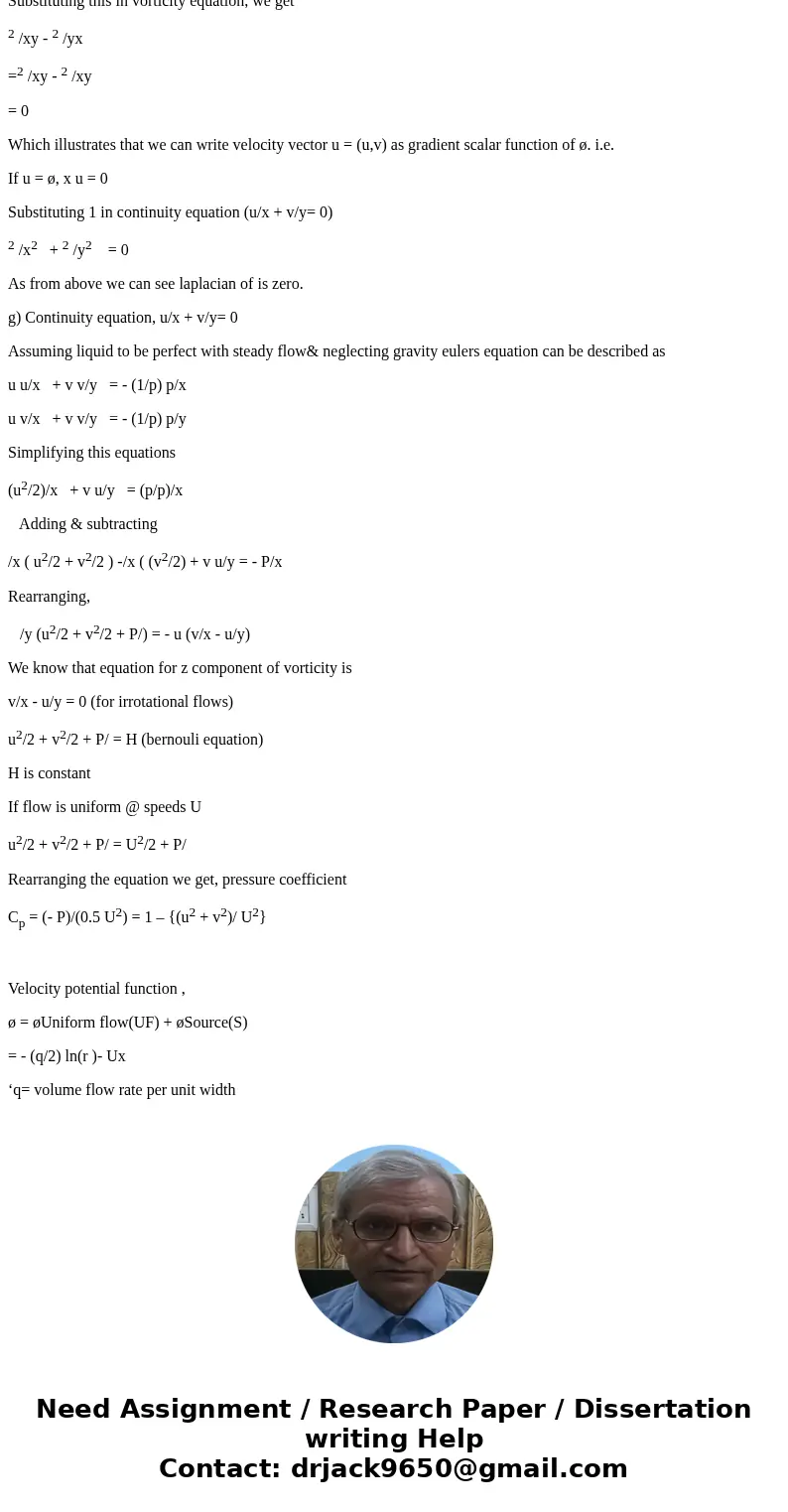
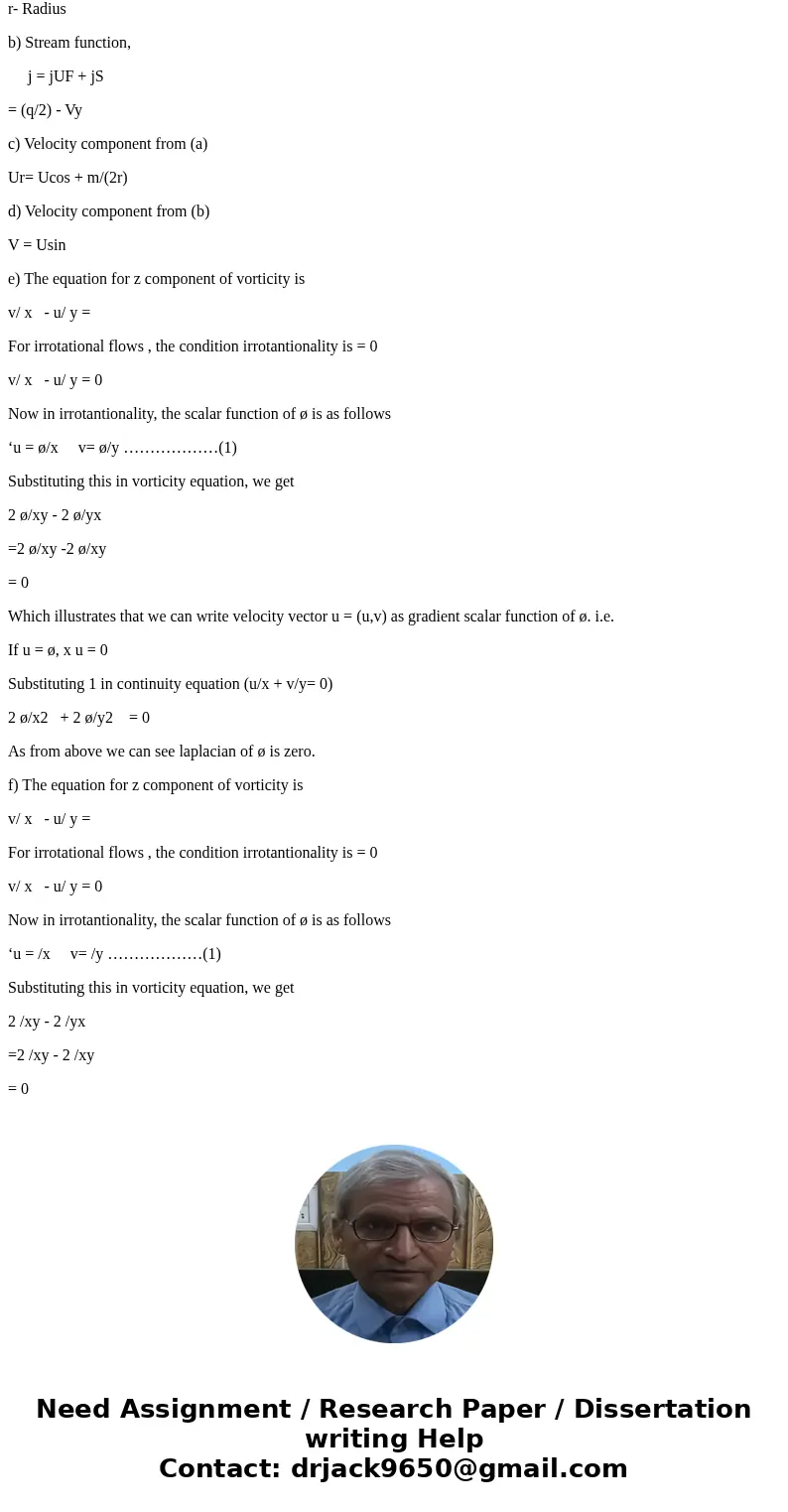
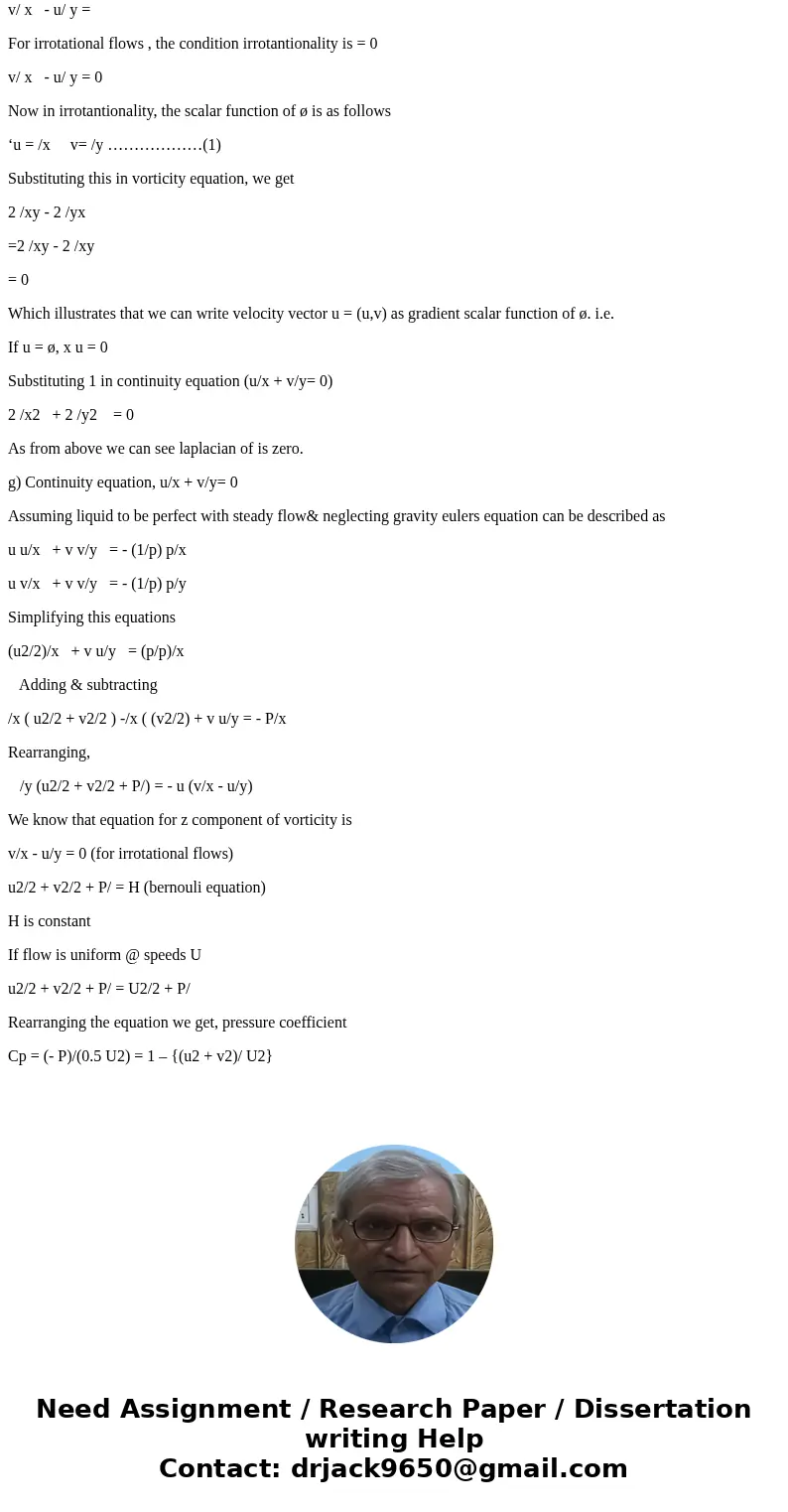
 Homework Sourse
Homework Sourse